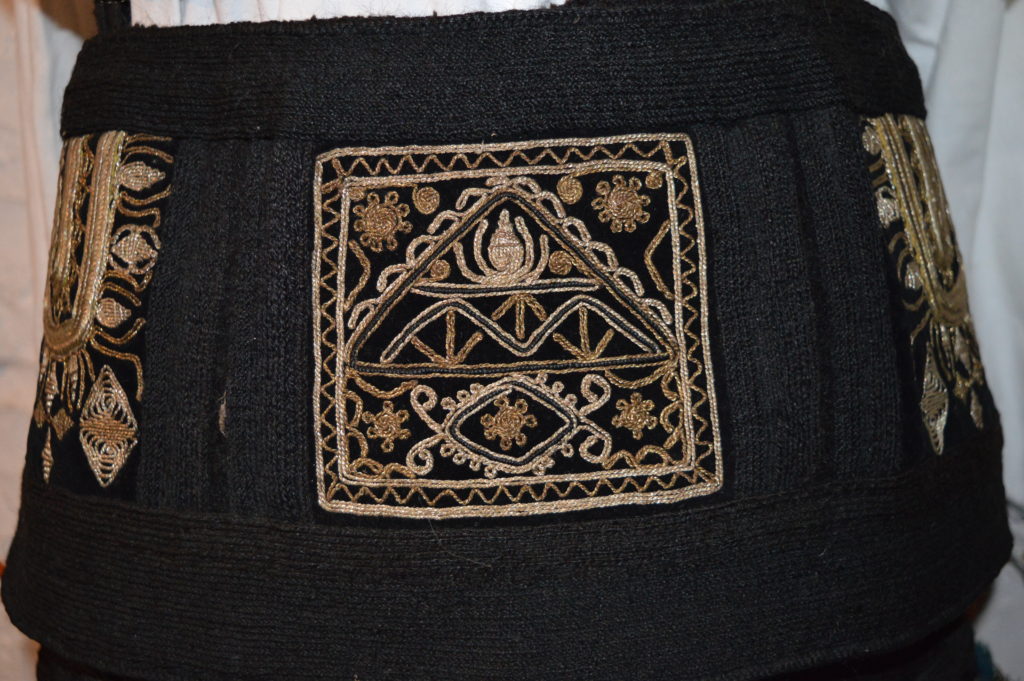A Tableau for Self Expression

The xhubleta Age began crafting at such a young age were meant for her married life. These xhubleta were different from the ones that she wore as a child. Instead of a pattern of black and white stripes, the base color of the new xhubleta was almost completely black. The black xhubleta that Age wore signified that she was a married woman.
It was traditional for women to build a number of xhubleta for their life beyond girlhood (Dukgilaj, 2018). Some women produced three, while others crafted up to nine (Dukgilaj, 2018). Age created five xhubleta for her wedding day. She worked on these dresses for nine years, from the age of nine until she turned eighteen (Vuktilaj A., 2018). These xhubleta were not to be worn until the day of her marriage. If a woman owned multiple xhubleta, she would be married in her most beautiful dress (Nini, 2013). On a woman’s wedding day, all these xhubleta would be sent with the bride and her belongings to her husband’s home (Nini, 2013).
“On my wedding day I wore the most beautiful [xhubleta] that I had.” – Age
The dresses were not entirely black. A thin white stripe may be present on the bottom edge of the skirt (Dukgilaj, 2018), along with different decorations, details, and symbols (Vuktilaj A., personal communication, Nov. 12th, 2018). As the creator of her own xhubleta, Age had some control over what symbols she placed on them. Age selected classic motifs to display on her xhubleta.
“Did you put any symbols on the xhubleta that you made yourself, did they have a certain meaning? Or did you just put on something that you liked?”
“I put symbols on that I liked.”
“Did they have any meaning?”
“No, I took the ones that I liked.”
– Age, 2018
These symbols were part of a woman’s external appearance, which may be deliberately altered to reflect her tastes, or purposely adapted to reflect her individual identity (Kuper, 1973). Age’s choice in symbols appeared to reflect her personal taste. Many women chose to adorn their xhubleta in symbols reflecting their daily routines and the nature that is such an important part of their lives on a daily basis (Berhami, 2018). Some women’s choice of symbols may have even been restricted, and may not have been forms of individual creativity – “If you ask any of the women who’ve worked on these about why they used a particular design they would answer ‘kështu bëhet’ – ‘that’s the way it’s done.’” (Gowing, 2017 p. 119).
“Any characteristic symbol in the xhubleta, do you remember?”
“I do not know, some flowers, some eagles, someone else had embroidered a name, everyone has had different things, some had zigzag lines.”
– Tonine, 2018
In addition to the decoration of the skirt, pieces were added to the xhubleta to show important moments in a woman’s life. One such ornament was a silver chain attached to the postava that was decorated according to the number of children a woman had. For every child that was born, she added a silver sun or half moon, depending on if the child was a boy or girl respectively (Berhami, 2018). These examples of symbolism on the dress allowed an onlooker to understand fragments of a woman’s life solely from the clothes she wore.
Other symbols allowed the women to express their personal status in the community. In many cultures, “clothing is an intimate part of the total status system” and can display this status (Kuper, 1973 p. 349).
“By looking at the xhubleta could you tell if they were from a wealthy family or not wealthy family?”
“Yes, because there were lesser quality (weaker) materials. The poor had weaker materials. The ones that had nicer houses usually had nicer xhubletas.”
– Age, 2018
If a family were in good economic standing, the women would have more xhubleta (Shkurtaj, 2018). In addition, the amount jewelry present on the xhubleta was an indicator of the family’s status – exquisite jewelry and embroidery adorned the xhubleta. Quality was another measure. Wealthy families used a golden filigree to decorate the xhubleta, while poorer families may use an imitation thread because they could not afford the precious metal (Berhami, 2018).
In some cases, this jewelry was given to the bride on the day of her wedding. If the woman were marrying into a wealthy family she would be provided a xhubleta with full accessories in gold (Berhami, 2018). One common type of gift to the bride was a chain of coins from different locations. The socio-economic position and religion of the family influenced the coins found on these tokens.

